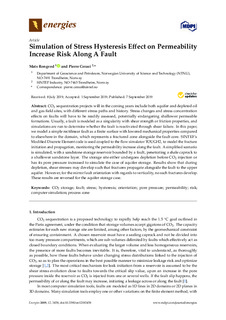| dc.contributor.author | Rongved, Mats | |
| dc.contributor.author | Cerasi, Pierre | |
| dc.date.accessioned | 2019-11-18T11:53:10Z | |
| dc.date.available | 2019-11-18T11:53:10Z | |
| dc.date.created | 2019-10-09T14:16:19Z | |
| dc.date.issued | 2019 | |
| dc.identifier.issn | 1996-1073 | |
| dc.identifier.uri | http://hdl.handle.net/11250/2629011 | |
| dc.description.abstract | CO2 sequestration projects will in the coming years include both aquifer and depleted oil and gas field sites, with different stress paths and history. Stress changes and stress concentration effects on faults will have to be readily assessed, potentially endangering shallower permeable formations. Usually, a fault is modeled as a singularity with shear strength or friction properties, and simulations are run to determine whether the fault is reactivated through shear failure. In this paper, we model a simple rectilinear fault as a finite surface with lowered mechanical properties compared to elsewhere in the domain, which represents a fractured zone alongside the fault core. SINTEF’s Modified Discrete Element code is used coupled to the flow simulator TOUGH2, to model the fracture initiation and propagation, monitoring the permeability increase along the fault. A simplified scenario is simulated, with a sandstone storage reservoir bounded by a fault, penetrating a shale caprock to a shallower sandstone layer. The storage site either undergoes depletion before CO2 injection or has its pore pressure increased to simulate the case of aquifer storage. Results show that during depletion, shear stresses may develop such that fractures propagate alongside the fault to the upper aquifer. However, for the mirror fault orientation with regards to verticality, no such fractures develop. These results are reversed for the aquifer storage case. | nb_NO |
| dc.language.iso | eng | nb_NO |
| dc.publisher | MDPI | nb_NO |
| dc.rights | Navngivelse 4.0 Internasjonal | * |
| dc.rights.uri | http://creativecommons.org/licenses/by/4.0/deed.no | * |
| dc.title | Simulation of stress hysteresis effect on permeability increase risk along a fault | nb_NO |
| dc.type | Journal article | nb_NO |
| dc.type | Peer reviewed | nb_NO |
| dc.description.version | publishedVersion | nb_NO |
| dc.source.volume | 12 | nb_NO |
| dc.source.journal | Energies | nb_NO |
| dc.source.issue | 18 | nb_NO |
| dc.identifier.doi | 10.3390/en12183458 | |
| dc.identifier.cristin | 1735540 | |
| dc.description.localcode | © 2019 by the authors. Licensee MDPI, Basel, Switzerland. This article is an open access article distributed under the terms and conditions of the Creative Commons Attribution (CC BY) license (http://creativecommons.org/licenses/by/4.0/). | nb_NO |
| cristin.unitcode | 194,64,90,0 | |
| cristin.unitname | Institutt for geovitenskap og petroleum | |
| cristin.ispublished | true | |
| cristin.fulltext | original | |
| cristin.qualitycode | 1 | |

